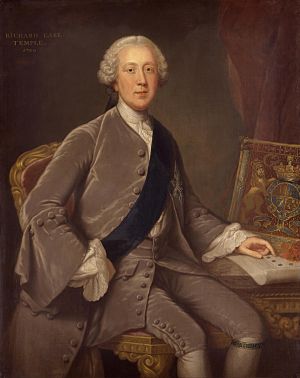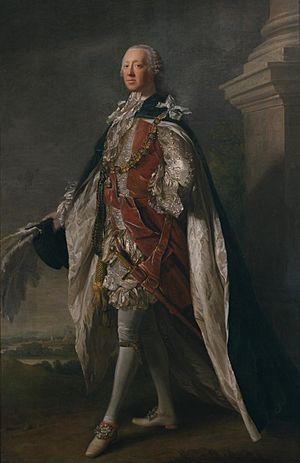Richard Grenville-Temple, 2nd Earl Temple facts for kids

Richard Grenville-Temple, 2nd Earl Temple (born September 26, 1711 – died September 12, 1779) was an important British politician. He is best known for working closely with his brother-in-law, William Pitt. They served in the government together during the Seven Years' War from 1756 to 1761. He and Pitt both resigned because they disagreed with the government's decision not to declare war on Spain.
Contents
Early Life and Family
Richard Grenville-Temple was the oldest son of Richard Grenville and Hester, who later became Countess Temple. He was born in Wotton Underwood, Buckinghamshire. He went to school at Eton College. In 1734, he became a member of Parliament for the town of Buckingham.
In 1752, his mother passed away. Richard inherited her titles and the large estates of Stowe and Wotton. At this time, he added "Temple" to his last name, becoming Richard Grenville-Temple. On May 7, 1737, he married Anna Chamber, who was a wealthy heiress.
Working with William Pitt
How Did He Become Important?
A big moment in Richard Grenville-Temple's political life happened in 1754. His sister, Hester, married William Pitt, who later became Earl of Chatham. Even though Lord Temple wasn't known for being a great leader on his own, his career became closely tied to his brother-in-law's.
His Role in Government
In November 1756, Lord Temple became the First Lord of the Admiralty. This was a top job in the navy, part of the government led by Devonshire and Pitt. However, King George II did not like him very much. Because of this, the King removed both Temple and Pitt from their jobs in April 1757.
Later that year, in June, a new government was formed. It was a partnership between Newcastle and Pitt. In this new government, Temple was given the job of Lord Privy Seal. This role involved looking after the King's personal seal.
Why Did He Resign?
In 1761, Pitt wanted to declare war on Spain. Lord Temple was the only person in the government who supported Pitt's idea. Because their plan was not accepted, both Temple and Pitt resigned from their positions on October 5.
Later Political Career

After leaving the government, Lord Temple became known for being a very strong and sometimes difficult politician. He even said he "loved faction," meaning he enjoyed political disagreements. He also had a lot of money to spend on these activities.
Disagreements with His Brother
He did not get along well with his younger brother, George Grenville. When George became the head of the government in April 1763, Lord Temple was not given a job. However, the brothers made up before 1765. At that time, Temple refused to join the government and also convinced Pitt not to join.
Refusing to Join Pitt's Government
In July 1766, Pitt finally agreed to form a new government. But Lord Temple refused to join it. He was upset because even though he was offered a top job (the Treasury), he wasn't allowed to have an equal say with Pitt in choosing other officials. After this, Temple started to spread negative stories about Pitt. He and his brother George worked together to oppose the government.
Retirement from Public Life
After his brother George Grenville died in 1770, Lord Temple mostly stopped being involved in public life.
Charity Work and Support
Even though he was known for being a challenging politician, Earl Temple was involved with a famous charity in London. From 1760 to 1768, he served as a vice president for the Foundling Hospital. This hospital helped many children who had been abandoned by their parents in London. It's possible he joined this charity out of kindness. However, it might also have helped him gain status and connect with other important supporters, like the Duke of Bedford and the Earl of Dartmouth.
Lord Temple also gained a lot of money from his marriage in 1737 to Anne Chambers. Anne was the daughter and co-heiress of Thomas Chambers. She even had a book of her poems printed in 1764.
Love for Cricket
Like his friend George Montagu-Dunk, 2nd Earl of Halifax, Richard Grenville-Temple was very interested in cricket. The first time we know he was involved in the sport was in August 1741. He was the boss and captain of the Buckinghamshire county team. He and Halifax organized a match between Northamptonshire and Buckinghamshire at Cow Meadow, Northampton.
Death
Earl Temple died in early September 1779, when he was 67 years old. He passed away after falling from his phaeton, which was a type of open carriage. He only had one daughter, who died when she was a baby. So, his nephew, George Nugent-Temple-Grenville, inherited his title as Earl.
See also
- Grenvillite

